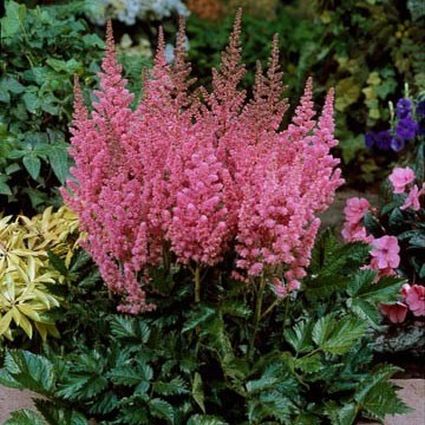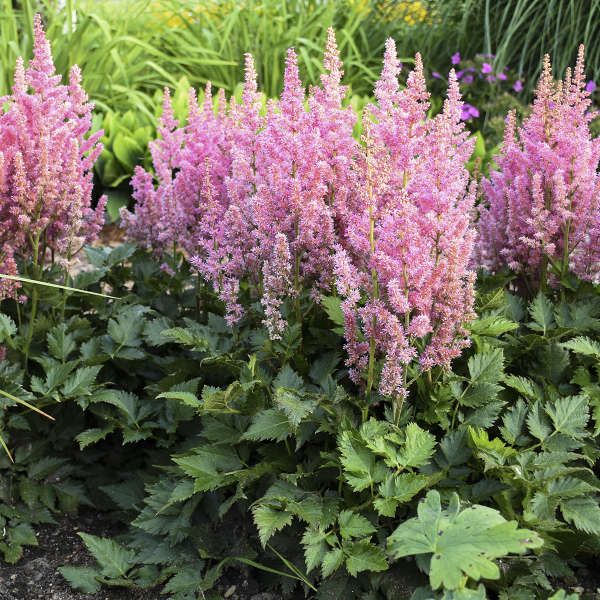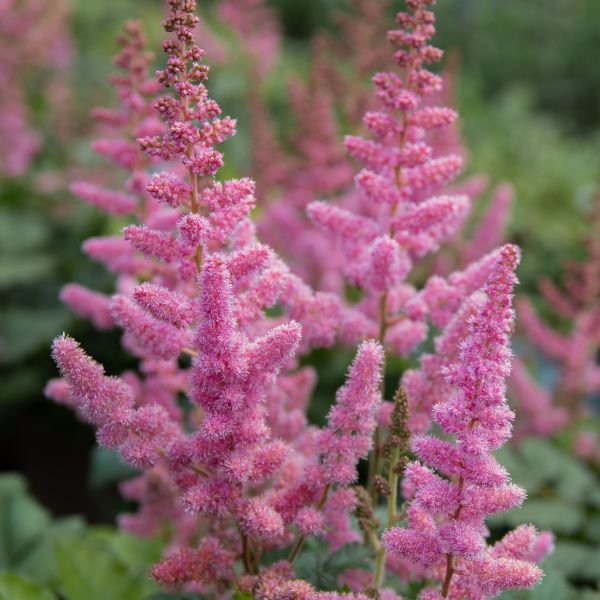


Visions in Pink Astilbe
Astilbe chinensis 'Vision in Pink'
92 reviews
Visions in Pink Astilbe
Astilbe chinensis 'Vision in Pink'
92 reviews
- Thrives in partial shade
- Drought tolerant once established
- Attracts pollinators to the garden
- Recommended by landscape designers for optimal fit in real yards
$69.00
$99.00
30% Off
- Ships to in 3-5 Days
- Free Shipping Over $150
- Plant Arrival Guarantee
- In Stock
- Free Plant Consult
$200 - Landscape-Approved: Every Plant We Sell Comes With Design Expertise Behind It
1 Gallon
We are sorry, product is currently out of stock due to seasonal availability. Please check the "Related plants available in your area" section below
Not just beautiful - intentionally selected by ShrubHub's 3D landscape design team to fit real-world spaces and maximize yard potential.
Why Visions in Pink Astilbe?
Visions in Pink Astilbe is a perennial plant known for its feathery spikes of soft pink flowers that bloom in the summer. This particular variety, Astilbe chinensis 'Vision in Pink', stands out for its dark green foliage and compact growth habit. It is low-maintenance and thrives in shady, moist environments, making it a popular choice for garden borders or as a backdrop for other plants.
Sunlight
Visions in Pink Astilbe requires partial to full shade for optimal growth, but it can tolerate some sunlight. It is best to provide it with dappled sunlight or morning sun and afternoon shade to prevent the leaves from scorching.
Watering
Visions in Pink Astilbe requires consistent watering to keep the soil evenly moist. It prefers moist, well-drained soil and should not be allowed to dry out completely. Adequate watering helps promote healthy growth and prevents wilting.
Fertilizing
Visions in Pink Astilbe requires a balanced fertilizer with nitrogen, phosphorus, and potassium. A slow-release fertilizer specifically formulated for flowering plants can help promote healthy growth and vibrant pink blooms.
Visions in Pink Astilbe is a versatile and stunning plant that adds color, texture, and vertical interest to shade gardens, borders, and woodland areas. It thrives in partial to full shade, making it an excellent choice for gardens with shady or woodland areas. With its beautiful feathery plumes of pink flowers that bloom in summer, it creates a captivating display in your garden.
This plant is suitable for USDA hardiness zones 4 to 8, ensuring that it can adapt well to various gardening environments. It prefers moist, well-drained soil with a slightly acidic pH. Providing regular watering and organic matter will help it thrive.
In addition to its aesthetic appeal, Visions in Pink Astilbe attracts bees and butterflies, making it a pollinator-friendly plant. Attracting these beneficial insects contributes to a thriving ecosystem in your garden.
Visions in Pink Astilbe is also a versatile plant that can be used as a cut flower in floral arrangements, allowing you to bring its delicate beauty indoors. It is also resistant to deer and rabbits, making it a low-maintenance choice for gardeners.
One fascinating aspect of Visions in Pink Astilbe is its ability to bring a sense of tranquility to any garden or landscape. Its delicate, airy flowers and lush foliage create a soothing and serene atmosphere, perfect for creating a peaceful retreat in your outdoor space. Whether planted in a shade garden or used as a focal point in mixed borders, Visions in Pink Astilbe adds grace and elegance to any landscape design. Its compact size also makes it suitable for container gardening, allowing you to adorn patios, balconies, or other small spaces with its beauty. Get ready to enjoy the beauty and versatility of Visions in Pink Astilbe in your garden.
Plant Information:
| Botanical Name: | Astilbe chinensis 'Vision in Pink' |
| USDA Zones: | 4 - 8 |
| Water: | Moderate |
| Exposure: | Full Sun |
| Soil Needs: | Well Drained |
| Mature Height: | 24 - 30 inches |
| Mature Spread: | 18 - 24 inches |






Pollination Info
Pollination Information for Visions in Pink Astilbe (Astilbe chinensis 'Vision in Pink')
Visions in Pink Astilbe (Astilbe chinensis 'Vision in Pink') is a perennial herbaceous plant that belongs to the Saxifragaceae family. It is an ornamental flowering plant that is commonly grown for its showy pink plumes that bloom in mid-summer.
The plant is pollinated primarily by insects such as bees, butterflies, and flies. The flowers of Visions in Pink Astilbe are adapted for insect pollination and have a sweet fragrance that attracts these pollinators.
The flower structure of this plant is designed to attract pollinators. The flowers have small nectar glands at their base, which provide a reward for the pollinators. The petals are also brightly colored and produce a sweet fragrance that attracts pollinators from a distance.
Visions in Pink Astilbe is a self-sterile species, meaning that it cannot fertilize itself. Cross-pollination between plants is necessary for seed production. To ensure successful pollination, it is recommended to plant a cluster of several individuals close together to increase the chances of cross-pollination between them.
Overall, Visions in Pink Astilbe is an important plant for pollinators, providing them with a source of nectar and pollen. It is an easy-to-grow plant that can thrive in a variety of growing conditions and is an excellent choice for adding color and texture to a garden.
FAQ
Visions in Pink Astilbe (Astilbe chinensis 'Vision in Pink') FAQ:
What is Visions in Pink Astilbe?
Visions in Pink Astilbe is a perennial flowering plant from the Astilbe family that is known for its beautiful pink flowers that bloom in summer. It is a popular garden plant due to its low maintenance requirements and showy blooms.
What are the ideal growing conditions for Visions in Pink Astilbe?
Visions in Pink Astilbe thrives in moist, well-drained soil and partial shade. It prefers soil that is slightly acidic and moist to the touch. In hot climates, it will appreciate some protection from the midday sun.
How big does Visions in Pink Astilbe grow?
Visions in Pink Astilbe grows to be about 18 to 24 inches tall and 12 to 18 inches wide. It is a compact plant that is perfect for border gardens or as a ground cover under trees.
When does Visions in Pink Astilbe bloom?
Visions in Pink Astilbe blooms in mid to late summer, usually around July and August. Its showy pink flowers rise above its foliage on tall, slender stems and have a delicate, feathery appearance.
How do I care for Visions in Pink Astilbe?
Visions in Pink Astilbe is a low maintenance plant that requires minimal care. To keep it healthy and blooming, make sure to water it regularly and keep the soil moist. You can also fertilize it once in the spring to promote healthy growth. Prune back any dead or wilted foliage to keep it tidy.
Can Visions in Pink Astilbe be grown in containers?
Yes, Visions in Pink Astilbe can be grown in containers as long as the container is large enough to accommodate its roots and provide adequate drainage. It will appreciate a soil mix that is rich in organic matter and regular watering to keep the soil moist.
Will Visions in Pink Astilbe attract pollinators?
Yes, Visions in Pink Astilbe is a great plant for attracting pollinators such as butterflies and bees to your garden. Its showy flowers provide a source of nectar for these insects, making it an important plant for supporting local ecosystems.
Are there any pests or diseases that affect Visions in Pink Astilbe?
Visions in Pink Astilbe is generally a disease-resistant plant, but it can be susceptible to powdery mildew if it is grown in overly humid conditions and lacks good airflow. Keeping the foliage dry and removing any infected leaves can help prevent the spread of this fungal disease. As for pests, slugs and snails may occasionally feed on the foliage, but they can be easily controlled with slug bait or handpicking.
Can Visions in Pink Astilbe be propagated?
Yes, Visions in Pink Astilbe can be propagated by division in the spring or fall. Dig up the plant and carefully separate the roots into smaller sections, making sure that each section has several stems and a good root mass. Plant the sections in well-drained soil and water them in well.
Planting & Care
Planting Visions in Pink Astilbe
Vision in Pink Astilbe requires a moist and shaded area to grow best. The ideal planting time for this perennial is in late spring or early fall when the soil is cool and moist.
- Start by choosing an area that is well-draining but consistently moist. Astilbe prefers shade or partial sun, so look for an area with dappled sun or bright shade.
- Prepare the soil by digging a hole that is deep enough to accommodate the root ball. Loosen the soil around the hole and mix in some compost for added nutrients.
- Place the Astilbe in the hole so that the crown is level with the soil surface. Backfill the hole and gently press down the soil around the plant.
- Water the Astilbe thoroughly after planting, and continue to water frequently until it is established.
Caring for Visions in Pink Astilbe
Ensuring the proper care for Vision in Pink Astilbe is crucial in maintaining its health and beauty. Follow these guidelines:
- Watering: Astilbe requires consistent moisture to thrive, so be sure to water it frequently, especially during hot and dry spells.
- Fertilizing: Astilbe benefits from regular fertilization with a balanced fertilizer. You can use a slow-release granular fertilizer in early spring and mid-summer, or you can use a water-soluble fertilizer every two weeks throughout the growing season.
- Pruning: Astilbe does not require much pruning, but you can remove spent blooms to encourage additional growth and prevent seed development. You can also trim back the foliage in the fall to tidy up the plant.
- Dividing: Astilbe can become crowded over time, and dividing it every three to four years can help maintain its health. Divide the plant in the spring or fall by digging up the entire clump and carefully separating it into sections.
- Winter Care: Astilbe is hardy in zones 4-9 and generally does not require much winter care. In colder climates, you can mulch around the plant to help insulate it against the freezing temperatures.
Following these tips will help ensure that your Vision in Pink Astilbe grows healthy and beautiful, blooming with its pink, feathery plumes year after year.
Check Out These Verified Customer Reviews:
Customer Reviews
4.7 out of 5 based on 92 reviews
Thank you! Your review has been submitted.
I am very happy with the quality of the Visions in Pink Astilbe I received. The plant looks healthy and vibrant. The website was user-friendly and I received my order in a timely manner. Overall, a great experience.
The astilbe plants looked even better in person than in the photos online.
Customer service was helpful
Item has been added to your cart.


